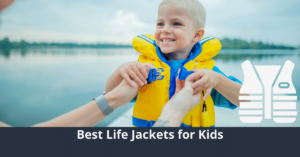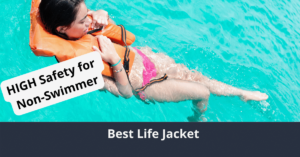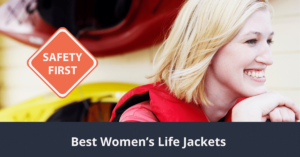There’s no debate to be had about the utter importance of life vests, particularly when it comes to our children. Whenever your children are on the beach or dock, boating, water skiing, or partaking in any other water sports, you should always protect them from drowning with a properly-sized, properly-fitted life jacket.
Manufacturers usually design their life jackets to fit either certain body weights, certain ages, or both. However, some children of a particular age can be either above or below the weight limit for a vest. In these cases, it is best to make sure that the life jacket supports their weight, but also fits snugly enough that it will not come off.
(If you are a teenager, you should visit: Best Teen Life Jackets)
In the following article, we’ll review some of the best youth life jacket options for kids weighing 50 to 90 pounds and recommended for ages 7-12 years. We will not only do an in-depth analysis of each of our life jacket recommendations, but also cover numerous other factors you need to consider before shopping for a child-sized vest. We also provide an interactive resource for US Drowning Statistics and Drowning Prevention. See our youth life vest reviews below:
Everything you will learn here
- The Best Youth Life Vests Reviewed (Top Picks)
- 1. Airhead WICKED Kwik-Dry Neolite Flex Life Vest
- 2. Stohlquist Youth Fit Life Jacket
- 3. Hardcore Water Sports Fully Enclosed Neoprene and Polyester Life Jacket Vest
- 4. O’Neill Youth SuperLite USCG Life Vest
- 5. Airhead Gnar Kwik-Dry NeoLite Flex Life Vest
- 6. Stearns Antimicrobial Nylon Youth Vest
- 7. Full Throttle Youth Life Vest
- The Best Youth Life Vests Buyer’s Guide – Making the Best Purchase
- Best Youth Life Jackets Comparison Chart
- Wrap Up
The Best Youth Life Vests Reviewed (Top Picks)
Let’s take a look at our product reviews now. The following options are in no particular order but we chose them based on their reliability, safety features, and reputation.
1. Airhead WICKED Kwik-Dry Neolite Flex Life Vest
- US Coast Guard Approved: This personal flotation device meets USCG requirements. Less bulky design for use when quick response is likely and offers a larger range of motion
- Closed Sided: Offers a tighter and more secure fit to keep your life vest in place. Designed for water sports, personal watercrafts and general boating safety
- Buckles & Zipper: Side release buckles open and close quickly while the zipper is easy and quick to fasten to ensure safety and security on the water
This stylish Type III life vest will fit children that weigh 50 to 90 pounds and features a heavy-duty zipper closure with two adjustable belts. This vest also boasts a Kwik-Dry NeoLite material that resists staining and sun damage. It is U.S. Coast Guard Approved and comes in a cool pink and zebra stripe pattern that helps ensure maximum visibility.
Part of what makes the Airhead WICKED such an excellent choice for kids is that it doesn’t limit their range of motion thanks to the segmented hinges. This innovation means less fussing around when it comes time to wear the vest. Similarly, the quick-drying fabric and lightweight foam will help keep kids comfortable all day by minimizing chafing and discomfort.
As with all Type III PFDs, this model will not flip children onto their backs when they enter the water. This design makes the vest most appropriate for kids that have some basic swimming skills. It also means that children will be able to swim freely without parents having to worry about accidents. For kids that are just entering their pre-teen years, the ability to feel independent is a big factor in a life vest.
Pros
- Designed for children in a weight range 50-90 pounds.
- Quick-drying material helps minimize discomfort
- Segmented hinges allow for freedom of movement
- Stain and sun damage-resistant
Cons
- Boys may not be huge fans of the pink color
- Children should have some basic swimming skills
- Zippers can break if not used gently
2. Stohlquist Youth Fit Life Jacket
- USCG Approved - Certified by the US Coast Guard, these life jackets meet stringent safety standards and suit all water activities. Whether boating, jet skiing, or simply enjoying a day on the water, you can trust these vests' reliable protection.
- Made for Growing Children - Available in options for 30-50 lbs and 50-90 lbs, these kids' life jackets suit various sizes and are fully adjustable for growing kids. The jacket ensures a snug fit, promoting comfort and confidence in water activities.
- All-Around Water Safety - Essential for any water adventure, this US Coast Guard Approved Stohlquist Kids Life Jacket ensures your child's safety while kayaking, tubing, or playing at the lake. Designed for comfort and easy adjustments, it’s perfect for all-day wear during time on the water.
Stohlquist Life Vests stand out among the pack due to the large cutaways for the wearer’s arms. This feature makes a huge difference when it comes to both range of movement and reduced chafing. The only exception to this is the topmost of the three straps, which is high enough to cause some potential scratching as children swim and play.
The Stohlquist Youth Vest is incredibly thin, with a lot less paneling than other similar style jackets. This innovation makes the vest much more comfortable when people are sitting, but still retains plenty of buoyancy to maximize safety. It has a 200D nylon outer shell with a hanging loop for easy drying and storage after a day in the water.
As with other Type III life vests, this jacket will not automatically flip children on their back when they enter the water. While great for kids who can swim, those without sufficient water skills should consider something else. The three heavy-duty straps help keep the vest snug, and are further reinforced by a vertical strap to prevent them from separating from the jacket over time.
Pros
- Designed for children who weigh 50 to 90 pounds
- Slim design minimizes chafing and maximizing movement
- Heavy-duty, reinforced straps
- Cost-effective choice for all budgets
Cons
- Children will need basic swimming skills
- Upper strap may cause chaffing under the arms
3. Hardcore Water Sports Fully Enclosed Neoprene and Polyester Life Jacket Vest
This Type III, U.S. Coast Guard-approved vest fits all kids who weigh 50 to 90 pounds. It also comes in a variety of bright, easy-to-spot colors, including red, orange, pink, yellow, and blue. The Hardcore Water Sports vest is solid – made out of heavy-duty foam and polyester. It also features neoprene at the shoulders and sides to enhance comfort and reduce chafing.
Like other Type III vests designed for children, this model does not move the wearer onto their back, which allows kids to swim at their leisure. The straps are one inch wide and secured by heavy plastic buckles. Also, the same style of vest comes in practically all available sizes. If they want, entire families can sport the same look, which can help encourage kids to wear their vests.
It’s debatable whether or not parents would prefer a zipper on the front, or if they’d feel the heavy-duty buckles are enough protection. While zippers can help ensure that a life vest fits a child snugly, they are also prone to breakage. A downside of this vest is that it is constructed of large pieces, so it will not bend or move easily.
Pros
- Designed for children who weigh 50-90 pounds.
- Colors are simple. Families can coordinate if they wish
- Heavy duty strap and buckle system
- Neoprene helps prevent chafing
Cons
- Doesn’t flex or move
- No zipper included
4. O’Neill Youth SuperLite USCG Life Vest
- US Coast Guard-approved life vest sizing should be measured at the widest part of the chest or stomach while sitting down. Properly fit life vest differs from your typical clothing size and should not be base on personal tight or loose fit preferences.
- U.S. Coast Guard Approved Personal Flotation Device (Type III)
- Designed to fit snug for your safety. Minimal bulk design allows full mobility and easy on and off.
One of the things that immediately stands out about the O’Neill Youth SuperLite Life Vest is its minimized bulk. The foam used in the design is both lightweight and comfortable and features mesh to help the vest drain and dry more quickly. The top of the three straps does not circle the back, but may still cause some chaffing near the chest and underarms.
The O’Neill is a Type III vest and features approval by the U.S. Coast Guard. The jacket is quite solidly-built, but it does have some light segmenting so that kids can still move around comfortably. It features three quick-release safety buckles but does not include a zipper. Though it is extremely buoyant, it will not push kids on their backs when they enter the water.
O’Neill is a company that earned its name offering clothing for water sports like surfing and jet skiing. Parents of children who are often reluctant to wear their life jackets due to discomfort will likely appreciate the added breathing room this vest provides. That said, this design can push up when children are sitting, putting pressure on their neck.
Pros
- Designed for children who weigh 50-90 pounds.
- Quick-release strap and buckle systems
- Very buoyant, but not uncomfortable
- An affordable option for all families
Cons
- Neck sits a little high
- Despite the breathability, it can still feel bulky
5. Airhead Gnar Kwik-Dry NeoLite Flex Life Vest
- USCG APPROVED – this personal flotation device meets USCG requirements for a Type III Life Jacket. Closed sides, buckle and Zipper closures built for secure fit for water sports enthusiasts where large range of motion is key. The light, segmented, hinged design allows freedom of movement in all directions
- COMFORT - Less bulky design for use when quick response is likely, offers a larger range of motion making it a favorite for water activities. Closed sides, zipper, and double buckle closure keep life jacket securely in place, KWIK Dry Neolite remains comfortable against the skin for all day wear
- MATERIAL - Durable, Quick-drying, and super soft. This fabric stays comfortable against your skin. Quick Dry Neolite is designed to wick away moisture and feel light and airy for a full day of boating, tubing, floating, jetting, paddling and play
Another quality youth life jacket from Airhead, the Gnar Kwik-Dry NeoLite Flex Life vest maximizes safety, comfort, and visibility. It features a particularly deep cutaway at the arms, which will keep children from chaffing as they go from wet to dry throughout the day. It is U.S. Coast Guard-approved and suitable for children weighing between 50 and 90 pounds.
This Type III vest features a fast-drying NeoLite material covered by stain-resistant, 200-Denier polyester. The bright, neon colors are suitable for both sexes and will ensure kids are easy to see both in the water and on land. The vest is breathable and flexible, ensuring that kids will have a full range of movement and dry quickly when they get out of the water.
The design of the vest is quite standard and includes a zipper and two heavy-duty waist buckles. Both buckles are “quick-release” for an added measure of safety. As with similar designs, this vest is only suitable for children that have some swimming experience. Children who cannot swim should invest in a jacket that rolls them on their backs when they enter the water.
Pros
- Designed for children who weigh 50-90 pounds.
- Material is quick-drying to avoid discomfort
- Designed with hinges for added movement
- Deep cutaways at the arms minimize chafing
Cons
- Children should have some basic swimming skills
- Zippers can break if not used gently
6. Stearns Antimicrobial Nylon Youth Vest
- US Coast Guard-approved life jacket
- Protective later avoids foul smell
- Great for a day on the boat or beach and in the pool or lake
The manufacturer of this product goes out of its way to provide a solution to a common life vest problem. In fact, for many consumers, durability is not the most significant factor in replacing vests. Instead, it is the growth of mold or mildew in the foam. For this reason, the Stearns Antimicrobial Nylon Youth Vest features an antimicrobial chemical that inhibits this.
This Type III vest boasts a deep, well-cushioned cutaway at the arms, which helps minimize chafing on the sides. Like other products of this type, it features a three-buckle system where the third buck sits high on the chest. This design is great for ensuring a snug fit, but the area where the strap meets the chest can often rub the inside of the child’s arms when they swim.
Most of the foam cushioning in the Stearns Vest is in the front, which means kids will have an easier time staying upright when they enter the water. Though this may inhibit swimming somewhat, it is much better for safety. The flat, minimal back also ensures that kids can sit comfortably without the vest riding up.
Pros
- Designed for children who weigh 50-90 pounds.
- Material inhibits the growth of bacteria and mold
- Large cutaway for minimized chafing on the arms
- The flat-back design makes for comfortable sitting
Cons
- Top strap can rub arms when swimming
- May inhibit swimming somewhat
7. Full Throttle Youth Life Vest
- Adjustable belts and chest strap to keep vest from riding up
- Heavy-duty nylon fabric and lightweight flotation foam
- Bright colors for better visibility on the water
This stylish vest from Full Throttle will fit all kids who weigh between 50 and 90 pounds. It is bright orange, making it suitable for both boys and girls and ensuring easy visibility from long distances. The vest is also U.S. Coast Guard-approved and features a Type III design to help maximize comfort and mobility.
The Full Throttle Youth Life Vest utilizes a three-strap system and does not include a zipper. The lower two straps feature an additional piece of heavy-duty nylon, which keeps them from separating from the vest over time. The third strap is rather high on the chest. This concept is excellent for enabling a secure fit, but the nylon may rub the child’s arms as they swim.
Pros
- Designed for children who weight 50-90 pounds
- Deep cutaways at the arms minimize chafing
- Bright orange design for easy visibility
Cons
- The upper strap may rub against arms while swimming
- One-piece design limits movement and adds to the bulkiness
The Best Youth Life Vests Buyer’s Guide – Making the Best Purchase
When purchasing safety devices, particularly safety devices for your children, it’s a good idea to make sure you’re adequately informed about how the devices work. You should also know what features are most important for minimizing the chance of injury or discomfort, and for maximizing the life of your vest.
In the following Buyer’s Guide, we’ll take a close look at what separates a great youth life vest from a lackluster model.
The Types of PFDs
While they are commonly called “life jackets” or “life vests,” the technical term for these products is Personal Flotation Devices, or “PFDs.” Different models can come in a myriad of styles, colors, and designs, and feature any number of materials or products.
Life vests are mandated by the U.S. Coast Guard in certain circumstances, especially when children are involved. They come in five different types, each of which has a particular intended use. These types are important to know because there is no guarantee of protection if you wear the wrong PFD for the wrong activity.
Type I
This model of life vest is what you would mostly-likely find on an ocean-going vessel or cruise ship. They are meant for prolonged stays in the water and feature a buoyant neck that will turn most wearers vertical in the water. Type I vests can be difficult to swim in, but they require almost no effort to float.
Type II
You commonly see this model of life vest on small crafts used for fishing and sailing. It features simple construction, usually out of blocky foam, orange polyester, and a single buckle. These are emergency-use vests. They are hard to move in but will keep most people afloat in open water.
Type III
Type III PFDs are great for use near shore, on personal watercraft, or in situations where the wearer wants to retain a lot of movement. While they will keep people safe if they fall into the water, they will usually not turn wearers vertical or on their back.
Type IV
This class of PFDs is not wearable at all. Instead, passengers throw them to individuals who fall overboard to give them something to keep them afloat. You might commonly call them “lifesavers.” Newer models are square and feature orange nylon coverings.
Type V
This class of life vest requires a conscious user to function, so they are not recommended for casual boating. Though they may have some form of natural buoyancy, they often have to be inflated before the wearer enters the water.
Life Vest Materials to Consider
One of the factors that you must be aware of when choosing a life jacket for your seven to twelve-year-old is the material used in its construction. While nearly all vests feature some sort of foam material for buoyancy and some form of cover, the types of products used in the manufacturing process can vary widely.
On top of this, each will have its unique pros and cons and will react to long-term water exposure differently. Here are some common materials to consider:
Outer Coverings
Nylon – Many life vests feature nylon covering. This material is breathable, light, and soft enough on the skin to minimize irritation and chafing. Depending on the style of PFD, there may or may not be foam in between the nylon layers.
Though nylon is probably the most common covering, it is not always ideal. For instance, nylon can stay quite damp long after removing the PFD from the water. This can lead to mold growth that ends up making the vest smell terrible.
Vinyl – Vinyl has become a more common covering for life vests in recent years, thanks to the fact that it is long-lasting and more water-resistant than nylon.
On the other hand, vinyl can conduct heat on hot summer days. In fact, it can even create minor burns on the skin in some cases. Still, it remains a popular option for kids PFDs because it’s so easy to clean.
Neoprene – Another common life jacket covering is Neoprene, a quick-drying material often used in sporty, Type III vest designs. Many boaters, jet skiers, and fisherman prefer Neoprene because it fits quite snugly, but still offers plenty of breathability.
Mesh – Mesh is ultra-lightweight and breathable, but it is not very durable and can irritate the skin after just a few hours of wear. For this reason, many manufacturers combine mesh and neoprene together to maximize both comfort and mobility.
Floatation Types
Foam – The vast majority of life jackets, regardless of class, use foam in their construction. This material is naturally buoyant, inexpensive, and easy for manufacturers to make as rigid or as flexible as they want. In some cases, a manufacturer will “segment” the foam with nylon or Neoprene.
That said, most types of foam will retain water at times. This point is especially true for those covered with a substance like nylon, which also holds onto moisture for a long time. Trapped water means that mold and mildew can grow after multiple uses, resulting in a perfectly good life jacket having to be retired early.
Air – Inflatable jackets are standard in situations where there is minimal space. Those of us who have flown will recognize these flat, vinyl, or rubber vests from flight attendant demonstrations.
As with airplanes, inflatable life jackets are considered “emergency use only” by most boaters. They have no buoyancy on their own, so the wearer must be conscious in order to inflate them. Inflation usually requires the wearer to use a pull tab or string, which activates an internal compressed air mechanism.
Hybrid – Deep sea fisherman, military personnel, or boaters who need a lot of freedom of movement (such as sail boaters) will sometimes wear hybrid vests. These have a small amount of foam to prevent drowning, but wearers can also fill them with air in the case of a prolonged stay in deep water.
Properly Sizing a Youth Puddle Jumper or Vest
Wearing a life jacket that doesn’t fit properly can be almost as bad as wearing nothing at all. In some cases, ill-fitting life jackets can even be dangerous to the wearer and cause them to injure themselves in situations that would otherwise have been non-life-threatening.
That said, in most cases, these jackets are merely uncomfortable and can chafe or cut the skin of the wearer. Of course, comfort is still very important in a child’s vest, because older kids may adjust straps or undo buckles, putting themselves in danger.
Here, we’ll discuss the proper procedure for ensuring that the life jacket you’re considering fits your child correctly. Again, keep in mind that weight and age requirements are only a guide, and that you still need to consider how the vest looks and feels before making a purchase.
Start with the Recommended Weight
Start by checking for jackets that fit your child’s weight. If your child weighs 74 pounds, for instance, you would want to find them a vest in the 50 to 90-pound range. Keep in mind, you want to do this even if those jackets do not match their age range. Weight, after all, is a far better barometer for a snug fit than age.
Though all jackets have a unique construction, this will give you a good idea of how most products in this category will fit them.
Consider the Fit First
The fit of the life jacket is, by far, the most essential factor to consider. To check the fit, fasten the life jacket until it fits snugly around the wearer. Be sure that you don’t leave any buckles or fasteners undone. Once you’ve done this, ask the wearer how they feel.
They should be able to move their arms and upper body quite easily and not feel any uncomfortable materials rubbing against their skin. Rubbing will only cause chafing down the line, especially once they get wet. Check the jacket for excess space, and have them sit and bend over to ensure the vest doesn’t ride up or hit their chin.
Look at the Shape of the Vest
Some vests are noticeably bulkier than others, and some will feature deep cutaways at the arms. This is to make swimming easier and minimize chafing or rubbing on wet skin. A thinner, lighter design with a deep cutaway, for instance, is better for kayaking or riding a personal watercraft.
You should also be aware that various foam vest design will carry the bulk of their buoyancy in different areas. This factor will ultimately affect how the wearer moves in the water. A life jacket that has heavy foam in the back, for instance, will tip the wearer face down. The opposite will happen if the foam is heavy in the chest or waist.
Consider Chest Measurements
As with a well-fitting suit, the chest of the wearer will be a big determining factor in which life vests fit them best. Though this has more impact on adults than on children, it is possible for kids nearing their teenage years to have rapidly-growing upper bodies.
If you find that vests in your child’s weight range do not fit properly, consider measuring the circumference of their chest and using that to find the appropriate size. When in doubt, choose a vest that has a less-restrictive chest area or larger armholes.
Plan Your Vest Around Your Day
As mentioned, manufacturers design different vest classes (Type I, Type II, Type III, etc.) for very different uses. However, as consumers, we need to be aware of what we’re going to do on any given day that we put on a life vest.
When it comes to children, there is no room for error in ensuring they have the optimum protection for any water-related activity. Below, we’ve included a list of activities that take place on or near water, as well as some PFD recommendations for each.
Boating
According to the WHO, which has many statistics on drowning and drowning prevention, more than two-thirds of boating fatalities are drownings. On top of that, some 90% of drowning victims are not wearing life jackets. For this reason, the U.S. Coast Guard requires that all boats have one life jacket on board for every passenger.
For children under the age of 13, this life jacket must be worn at all times while the vessel is moving. The only exception is if they are safely below the deck or in an enclosed area.
These life jackets can be either Type I, II, or III, but cannot be inflatable or hybrid. In most cases, children in this age group prefer Type III vests because they don’t restrict their movement and are much less bulky.
(See our article on Best Boating Life Jackets)
Water Sports
Type III vests are also well-suited to water sports like jet skiing and water skiing. This preference is mostly due to the fact that Type III vests allow for plenty of movement and don’t make the wearer feel bulky or awkward.
It is worth noting again, however, that many Type III designs do not roll the wearer onto their backs upon entering the water. If a child is unable to swim, they should instead opt for a Type II vest, especially when participating in a high-speed sport that presents the possibility of head injury.
For kayaking or canoeing, movement is still an issue, but nowhere near as big an issue as capsizing. It’s imperative that parents closely supervise children when they are in the kayak or canoe. Kids should also consider wearing a Type II PFD. If they fall in and injure their head, this vest will bring them up to the surface and keep them upright.
(See our article on Best Water Sports Life Vests)
Shore Activities
Even on the shore, kids between the ages of seven and twelve should still wear PFDs when close to water. This is especially true if they are above water, such as on a dock, as they can fall in and hit their head upon entry.
For maximum safety, experts recommend a Type II PFD. If the child is older and has some swimming ability, a Type III is often sufficient.
(See our article on Best Non-Swimmer Life Vests)
Life Jacket Safety and Care Tips
- Life jackets should fit snugly and not significantly interfere with motion or swimming.
- If the wearer’s swimming ability is at all questionable, consider a model that will turn them upright or on their back.
- Adults are just as at risk of drowning as teens and children. Be a good example, and wear your vest as well.
- Life jackets should be comfortable. Older kids may adjust straps or loosen their vests if they experience chafing or itching. This can render the vest ineffective in an emergency.
- Vests that show any signs of wear and tear or mold should be immediately replaced.
- Rinse jackets with clean water after each use (especially if used in saltwater) and hang them to dry somewhere out of the sun.
- Never attempt to speed up the drying process with a hairdryer or other device. Using dryers can cause premature wear and potentially melt the jacket material.
- Store jackets in a cool, dry place.
Best Youth Life Jackets Comparison Chart
| Product Name | Price | Size(LxW) | Fit For (Weight in Pounds) | Unique Features |
|---|---|---|---|---|
| Airhead WICKED Kwik-Dry Neolite Flex Life Vest | $ | 15.5"x12.8" | 50-90 | Stain and sun damage-resistant |
| Stohlquist Youth Fit Life Jacket | $ | 17.2"x13.31" | 50-90 | Jacket will not automatically flip children on their back when they enter the water |
| Hardcore Water Sports Fully Enclosed Neoprene and Polyester Life Jacket Vest | $ | 20.98"x17.01" | 50-90 | Neoprene helps prevent chafing |
| O•Neill Youth SuperLite USCG Life Vest | $ | 14.5"x14" | 50-90 | Quick-release strap and buckle systems |
| Airhead Gnar Kwik-Dry NeoLite Flex Life Vest | $-$$ | 22.83"x16.3" | 50-90 | Material is quick-drying to avoid discomfort |
| Stearns Antimicrobial Nylon Youth Vest | $ | 18"x14" | 50-90 | Large cutaway for minimized chafing on the arms |
| Full Throttle Youth Life Vest | $ | 17.5"x15" | 50-90 | Deep cutaways at the arms minimize chafing |
Wrap Up
Regardless of their age or swimming experience, no child is ever completely safe when they are on or around water. The only way to minimize the risk of drowning is to ensure that they wear a U.S. Coast Guard-approved life vest at all times. Furthermore, it is crucial that vests fit each unique child properly to avoid injury or discomfort.
In the end, the great outdoors can still be a dangerous place. Try as we might, we cannot always prevent accidents. What we can do is maximize our family’s chances of staying safe in the event of an accident. For boating, fishing, and other water activities, a youth life vest can provide the safety and security kids – and parents – deserve.
Last update on 2025-04-30 / Affiliate links / Images from Amazon Product Advertising API

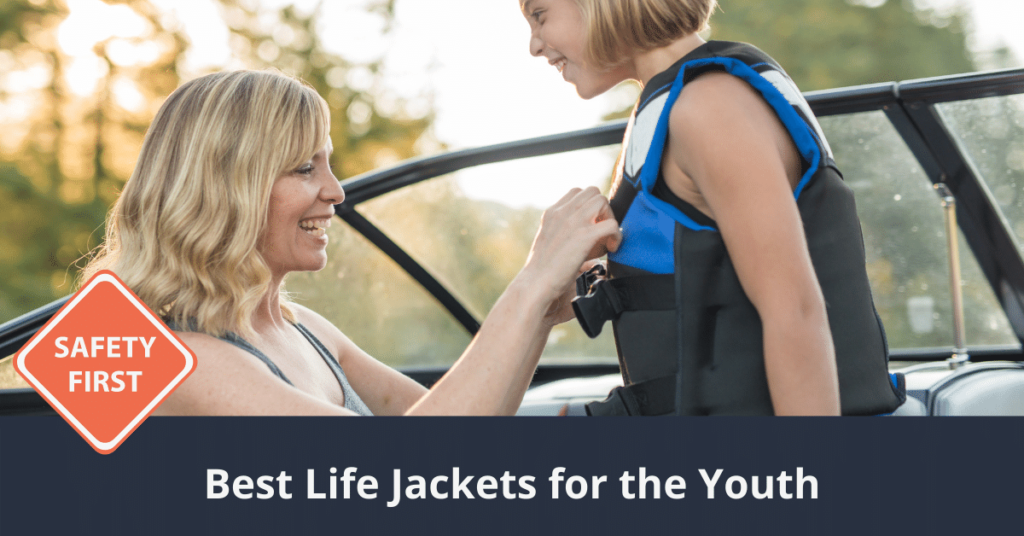








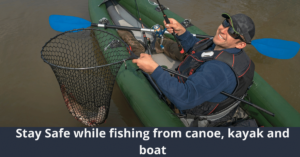
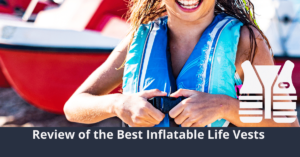
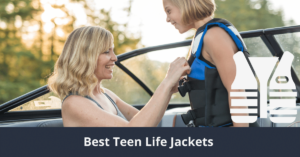
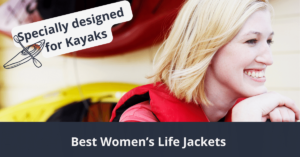
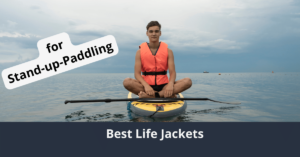
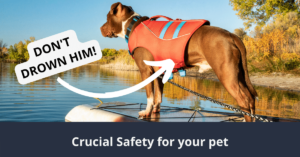
![7 Best Jet Ski Life Jackets with awesome fit [2023 guide] 17 Best Jet Ski Life Jacket](https://insmoothwaters.com/wp-content/uploads/2022/09/Best-Jet-Ski-Life-Jacket-300x157.png)
